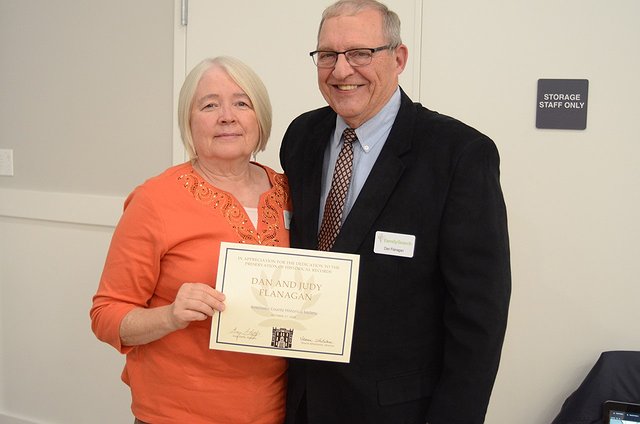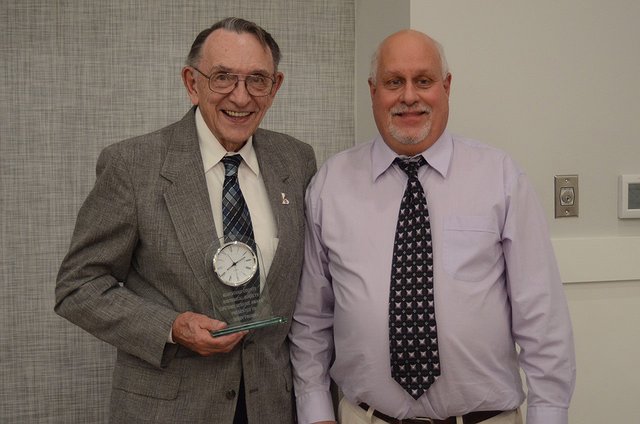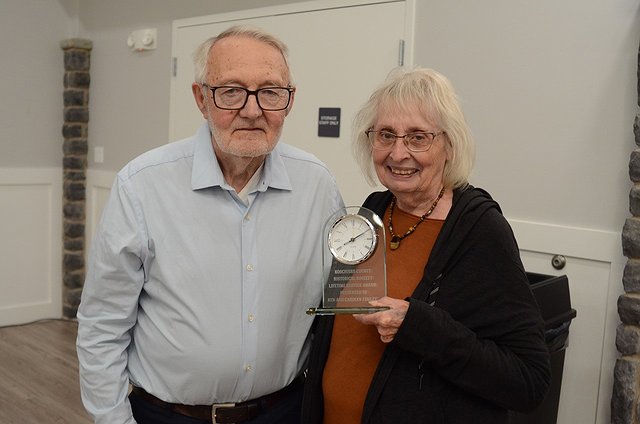Volunteers, New Director And Circus Topics At Historical Society Banquet
October 18, 2024 at 3:46 p.m.

Local volunteers and a new director were recognized at the 59th annual Kosciusko County Historical Society's banquet Thursday.
Ken and Carolyn Fawley and Jerry Frush were presented the first Lifetime Service Awards by Greg Steffe, new president and museum co-director. Each received an engraved crystal clock.
The Fawleys were recognized earlier by Sharon Whetstone for their volunteer work each month at the museum and Pound Store. They have been members of the historical society since 1981-82.
Frush, outgoing board president, was recognized for giving many years of selfless service to the organization. “This one is a real honor for me to present in my tenure with this organization,” said Steffe, adding Frush has served as a mentor, teacher and a trusted and dear friend.
Earlier in the evening, Dan and Judy Flanagan and the Fawleys were presented with certificates for their devotion and extraordinary service.
The Flanagans have been working on digitizing documents used in genealogy research in the possession of the historical society, which are deteriorating and the ink is disappearing. Dan Flanigan stated they just finished the 1899 indexes of tax records and in the last 1-½ years have created 215,000 images for just Warsaw.
Connie Black was also recognized. Black had received the Indiana Genealogy Association State Volunteer of the Year. She was nominated by Whetstone and county genealogist Dave Myers.
Black, who has volunteered since approximately 1986, “has been instrumental in developing and implementing leadership in the genealogy area in the society,” said Whetstone.
Black has transcribed, collated and indexed records from Tucker Funeral Home. She has worked with the Pioneer Families in the county, was instrumental in starting the cemetery project in 2008 after spending 40 years locating and taking photographs of tombstones in over 80 cemeteries in the county. She has worked on the obituary project, organizing the obituaries the society has accumulated, and creating a database of over 15,000, which can be found on Beacon.
“Connie has provided excellent leadership while working alongside our dedicated group of volunteers, that has created a work environment that builds on individual skills, and resources and what they like to do,” concluded Whetstone.
Appreciation was expressed to Sheila Strickland, co-director of the museum, who will leaving at the end of the year. Steffe noted when one door opens another door closes. Theresa Jones was introduced as the museum's new full-time director.
“I am thrilled to be working in what is the most beautiful and distinct building in Warsaw. But even more excited to be working with a team that is so devoted to preserving our local history and our genealogical records,” she said.
The program for the evening was presented by Bob Walsh on the history of circuses in Indiana. He noted in the 1900s 50% of the population lived on farms, the other 50% in towns. They looked forward to the county fairs, Chautauqua events and the circus. He noted when the circus came to town, everything shut down and “everybody went to the show.”
He talked about the history of the Ringling Brothers Circus, Barnum Bailey and the Hagenbeck Wallace Circus, which was from Peru. Eventually, Ringling bought out Barnum Bailey and Hagenbeck Wallace circuses and became a formable circus and known as the Ringling Bros and Barnum & Bailey Circus. He talked about the process of bringing a circus to town, the various circus wagons, modes of travel.
Walsh said the circus over two weeks would bring in 3,000 workers. They would use 220 eggs, 2,200 pounds of meat to feed the workers and made 10,000 pancakes each morning.
“When they would come to town, not only did everybody go see it, a lot of business owners were excited because they would buy all this stuff,” he noted. Contracts would be signed to purchase not only eggs and meat, but hay and other amenities.
He noted how the U.S. Army studied the circus on its efficiency in quickly setting up and tearing down the tents.
Walsh noted some of those involved in the early circuses still reside in Indiana, specifically the Peru area.
From traveling by horse drawn wagons to trains, the history of the circus and its roots in Indiana were noted by Walsh. He added 1956 was the last year tents were used, with the shows moving into coliseums.
Earlier in the evening, updates on the museum, library and genealogy library were presented by Steffe, Stickland and Whetstone.
Steffe noted the organization is a critical junction – keeping members and funds. He noted donations are down, grants have been sought to upgrade the society's computers, refurbish the Pound Store, and the board is exploring revenue options. He noted the board is looking at outreach programs with schools, including a potential essay contest with monetary prizes.
Regarding the financial situation, Steffe encouraged members to talk with county council and county commissioners regarding the discussion to re-evaluate funding to nonprofits. He stated the society receives $23,000 from the county, the loss of that money would be devastating.
He touched on the exhibits and the haunted jail tours. The goal with the tours was to raise $2,500, but after four nights, over $3,400 has been raised. With the success, plans are being implemented to tweak the program for next year. He noted a Dine 2 Donate program at Salvatori's on Nov. 12, where 20% of a bill will go to the society, if diners tell them they want to donate.
Strickland noted membership is up to 600 and the sponsors for the Thaddeus publication is at 12, with 15 needed. There were 1,200 visitors to the museum with 85 of those from out of the county. Four were out of the country – Germany and Ireland.
Whetstone noted there were eight to nine women volunteering in the genealogy department, averaging 250 hours a month. These women have spent time working on different projects and helping families find their roots.
A part of the annual meeting was also the election of officers and board members. It was noted June Thomas, Laurie Boss and Jerry Frush would be leaving the board. New officers will be: Steffe, president; Cynthia Green, vice president; Jan Sloan, accessor; Elaine Beeching secretary; Sheryl Hanna, assistant secretary; and Jim Tinkey, treasurer.
Elected to serve a three-year term on the board were Tinkey, Green, Sloan, Ron Shoemaker and Alan Alderfer.
Latest News
E-Editions
Local volunteers and a new director were recognized at the 59th annual Kosciusko County Historical Society's banquet Thursday.
Ken and Carolyn Fawley and Jerry Frush were presented the first Lifetime Service Awards by Greg Steffe, new president and museum co-director. Each received an engraved crystal clock.
The Fawleys were recognized earlier by Sharon Whetstone for their volunteer work each month at the museum and Pound Store. They have been members of the historical society since 1981-82.
Frush, outgoing board president, was recognized for giving many years of selfless service to the organization. “This one is a real honor for me to present in my tenure with this organization,” said Steffe, adding Frush has served as a mentor, teacher and a trusted and dear friend.
Earlier in the evening, Dan and Judy Flanagan and the Fawleys were presented with certificates for their devotion and extraordinary service.
The Flanagans have been working on digitizing documents used in genealogy research in the possession of the historical society, which are deteriorating and the ink is disappearing. Dan Flanigan stated they just finished the 1899 indexes of tax records and in the last 1-½ years have created 215,000 images for just Warsaw.
Connie Black was also recognized. Black had received the Indiana Genealogy Association State Volunteer of the Year. She was nominated by Whetstone and county genealogist Dave Myers.
Black, who has volunteered since approximately 1986, “has been instrumental in developing and implementing leadership in the genealogy area in the society,” said Whetstone.
Black has transcribed, collated and indexed records from Tucker Funeral Home. She has worked with the Pioneer Families in the county, was instrumental in starting the cemetery project in 2008 after spending 40 years locating and taking photographs of tombstones in over 80 cemeteries in the county. She has worked on the obituary project, organizing the obituaries the society has accumulated, and creating a database of over 15,000, which can be found on Beacon.
“Connie has provided excellent leadership while working alongside our dedicated group of volunteers, that has created a work environment that builds on individual skills, and resources and what they like to do,” concluded Whetstone.
Appreciation was expressed to Sheila Strickland, co-director of the museum, who will leaving at the end of the year. Steffe noted when one door opens another door closes. Theresa Jones was introduced as the museum's new full-time director.
“I am thrilled to be working in what is the most beautiful and distinct building in Warsaw. But even more excited to be working with a team that is so devoted to preserving our local history and our genealogical records,” she said.
The program for the evening was presented by Bob Walsh on the history of circuses in Indiana. He noted in the 1900s 50% of the population lived on farms, the other 50% in towns. They looked forward to the county fairs, Chautauqua events and the circus. He noted when the circus came to town, everything shut down and “everybody went to the show.”
He talked about the history of the Ringling Brothers Circus, Barnum Bailey and the Hagenbeck Wallace Circus, which was from Peru. Eventually, Ringling bought out Barnum Bailey and Hagenbeck Wallace circuses and became a formable circus and known as the Ringling Bros and Barnum & Bailey Circus. He talked about the process of bringing a circus to town, the various circus wagons, modes of travel.
Walsh said the circus over two weeks would bring in 3,000 workers. They would use 220 eggs, 2,200 pounds of meat to feed the workers and made 10,000 pancakes each morning.
“When they would come to town, not only did everybody go see it, a lot of business owners were excited because they would buy all this stuff,” he noted. Contracts would be signed to purchase not only eggs and meat, but hay and other amenities.
He noted how the U.S. Army studied the circus on its efficiency in quickly setting up and tearing down the tents.
Walsh noted some of those involved in the early circuses still reside in Indiana, specifically the Peru area.
From traveling by horse drawn wagons to trains, the history of the circus and its roots in Indiana were noted by Walsh. He added 1956 was the last year tents were used, with the shows moving into coliseums.
Earlier in the evening, updates on the museum, library and genealogy library were presented by Steffe, Stickland and Whetstone.
Steffe noted the organization is a critical junction – keeping members and funds. He noted donations are down, grants have been sought to upgrade the society's computers, refurbish the Pound Store, and the board is exploring revenue options. He noted the board is looking at outreach programs with schools, including a potential essay contest with monetary prizes.
Regarding the financial situation, Steffe encouraged members to talk with county council and county commissioners regarding the discussion to re-evaluate funding to nonprofits. He stated the society receives $23,000 from the county, the loss of that money would be devastating.
He touched on the exhibits and the haunted jail tours. The goal with the tours was to raise $2,500, but after four nights, over $3,400 has been raised. With the success, plans are being implemented to tweak the program for next year. He noted a Dine 2 Donate program at Salvatori's on Nov. 12, where 20% of a bill will go to the society, if diners tell them they want to donate.
Strickland noted membership is up to 600 and the sponsors for the Thaddeus publication is at 12, with 15 needed. There were 1,200 visitors to the museum with 85 of those from out of the county. Four were out of the country – Germany and Ireland.
Whetstone noted there were eight to nine women volunteering in the genealogy department, averaging 250 hours a month. These women have spent time working on different projects and helping families find their roots.
A part of the annual meeting was also the election of officers and board members. It was noted June Thomas, Laurie Boss and Jerry Frush would be leaving the board. New officers will be: Steffe, president; Cynthia Green, vice president; Jan Sloan, accessor; Elaine Beeching secretary; Sheryl Hanna, assistant secretary; and Jim Tinkey, treasurer.
Elected to serve a three-year term on the board were Tinkey, Green, Sloan, Ron Shoemaker and Alan Alderfer.







